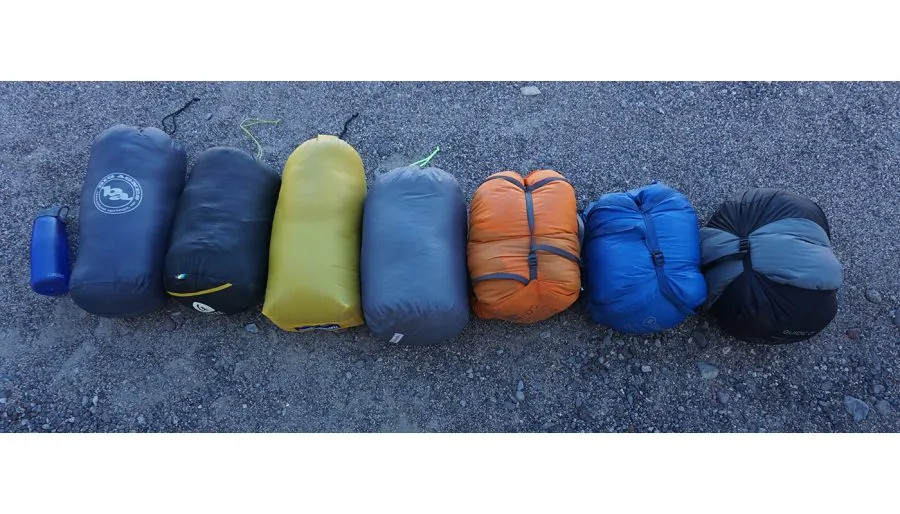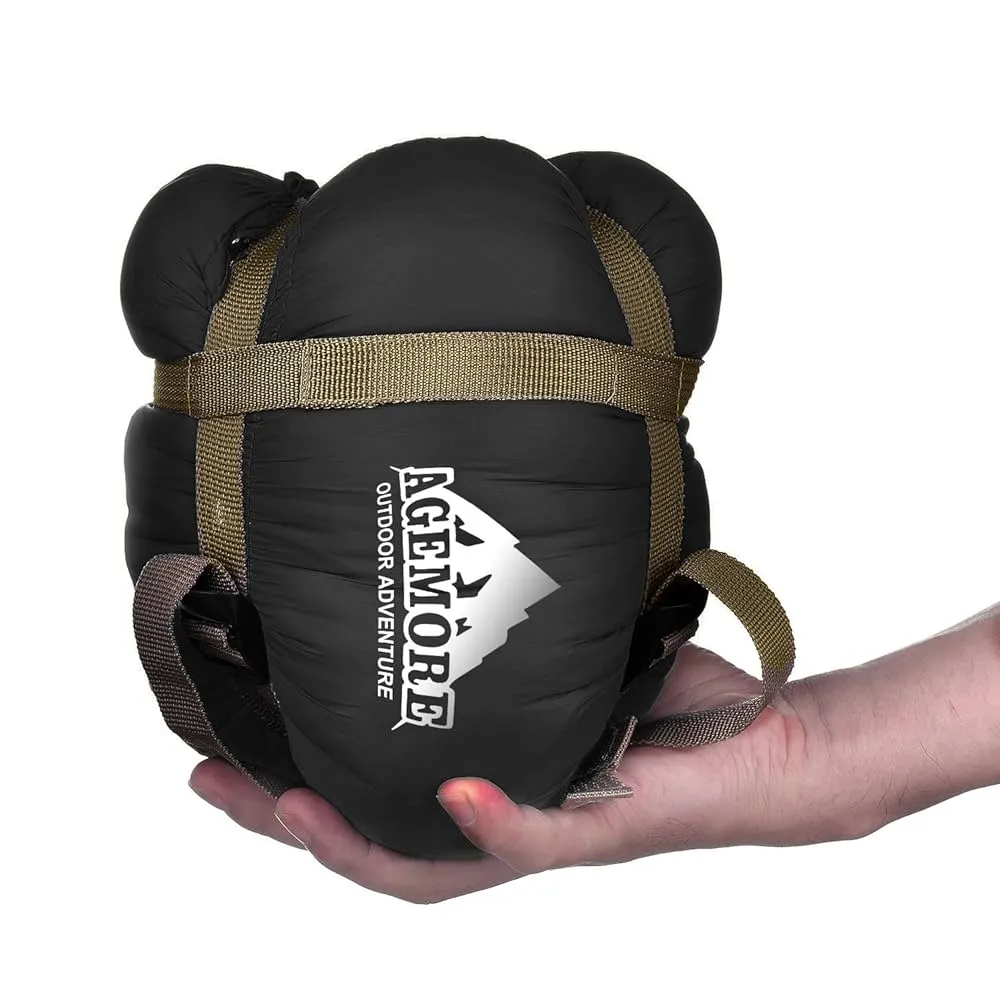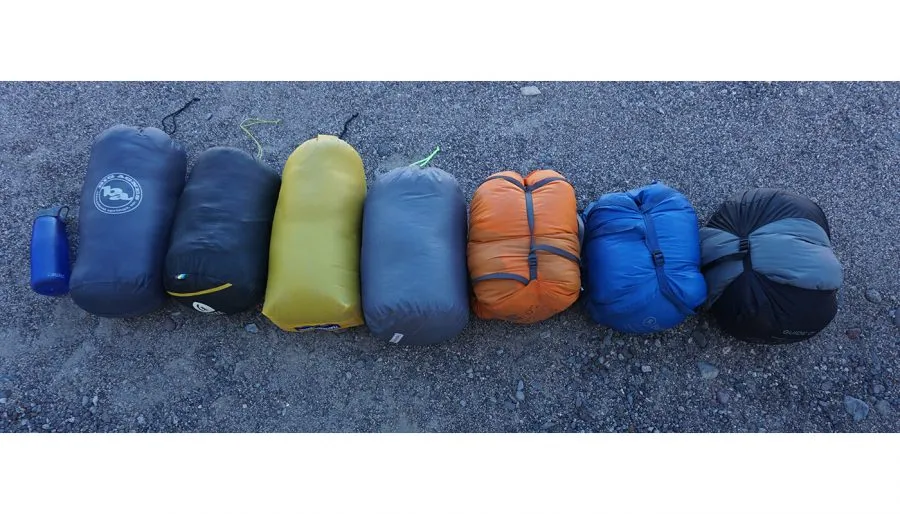Finding the right compact winter sleeping bag can make or break your cold weather camping experience. After testing dozens of bags across various winter conditions, I've compiled this comprehensive guide to help you choose the perfect balance of warmth, weight, and packability. Whether you're planning a multi-day winter backpacking trip or just need reliable gear for car camping, this guide covers everything you need to know about compact winter sleeping bags.
Visit NatureGuests.com for more outdoor gear reviews and adventure guides.
What Makes a Winter Sleeping Bag "Compact"
When I first started winter camping, I made the mistake of bringing a bulky 4-season bag that took up half my pack. After years of testing different compact winter sleeping bags, I've learned that true compactness isn't just about size—it's about the perfect balance of warmth, weight, and packability.
A genuinely compact winter sleeping bag should compress to roughly the size of a 2-liter bottle while still providing adequate insulation for temperatures below 20°F. The key lies in high-quality down insulation with fill power ratings of 800 or higher, combined with lightweight shell materials that don't compromise durability.
The most important factors that contribute to compactness include fill power (the loftiness of the down), baffle construction (how the down is contained), and shell fabric weight. I've found that bags using 15-denier ripstop nylon with 900+ fill power down offer the best compression ratios while maintaining warmth.

Key Metrics for Compact Winter Bags
- Weight: Under 3 pounds for temperatures down to 0°F
- Packed Size: Less than 8 liters compressed volume
- Fill Power: 800+ for optimal warmth-to-weight ratio
- Shell Fabric: 15-20 denier for durability without excess weight
Top 5 Compact Winter Sleeping Bags (Reviews)

1. Western Mountaineering UltraLite 20°F
Price: $620 | Weight: 1 lb 13 oz | Fill Power: 850+
After using this bag for three winters, I can confidently say it's one of the best compact winter sleeping bags available. The Western Mountaineering UltraLite strikes an exceptional balance between warmth and packability. I've slept comfortably in this bag during temperatures as low as 15°F with proper layering.
Pros: Excellent warmth-to-weight ratio, durable construction, lifetime warranty
Cons: Premium price point, narrow cut may not suit all sleepers
2. Feathered Friends Swallow UL 20°F
Price: $629 | Weight: 1 lb 11 oz | Fill Power: 950+
The Feathered Friends Swallow UL represents the pinnacle of compact winter sleeping bag design. I've taken this bag on winter backpacking trips in the Cascades and found it remarkably warm for its weight. The 950+ fill power down compresses incredibly small while maintaining excellent loft.
Pros: Highest quality down, superior compression, excellent draft collar
Cons: Expensive, requires careful handling of thin shell fabric
3. REI Co-op Magma 15°F
Price: $429 | Weight: 2 lb 3.6 oz | Fill Power: 850
The REI Magma 15 offers exceptional value in the compact winter sleeping bag category. While slightly heavier than premium options, it provides reliable warmth and comes with REI's excellent return policy. I've recommended this bag to several friends who were impressed with its performance-to-price ratio.
Pros: Great value, multiple size options, trusted brand backing
Cons: Heavier than competitors, less compressible than premium bags
4. Therm-a-Rest Hyperion 20°F
Price: $470 | Weight: 1 lb 5 oz | Fill Power: 900
The Therm-a-Rest Hyperion is the lightest compact winter sleeping bag in my collection. Its innovative design places more insulation on top where you need it most, while the bottom relies on your sleeping pad for insulation. This approach results in remarkable weight savings without sacrificing warmth.
Pros: Extremely lightweight, innovative design, excellent packability
Cons: Requires high-quality sleeping pad, narrow fit
5. Mountain Hardwear Phantom 0°F
Price: $680 | Weight: 2 lb 10 oz | Fill Power: 800
For serious winter conditions, the Mountain Hardwear Phantom 0°F is my go-to choice. While not the lightest on this list, it's remarkably compact for a 0-degree bag. I've used this bag during winter mountaineering trips where temperatures dropped well below zero, and it performed flawlessly.
Pros: Extreme warmth rating, durable construction, excellent hood design
Cons: Heavier than other options, higher price point
Buying Guide: Key Features to Consider
Temperature Rating Systems
Understanding temperature ratings is crucial when selecting compact winter sleeping bags. The EN/ISO rating system provides standardized measurements, but I've learned that personal factors significantly affect warmth. As a cold sleeper, I typically choose bags rated 10-15 degrees warmer than expected conditions.
The key ratings to understand are: Comfort (temperature where an average woman sleeps comfortably), Lower Limit (temperature where an average man sleeps without waking from cold), and Extreme (survival temperature). For winter camping, focus on the Lower Limit rating and add a safety margin.
Down vs. Synthetic Fill
After testing both types extensively, I strongly recommend down-filled compact winter sleeping bags for most users. Down provides superior warmth-to-weight ratios and compresses smaller than synthetic alternatives. However, synthetic fill performs better when wet and costs less.

Essential Features for Winter Use
- Draft Collar: Prevents heat loss around the neck area
- Hood Design: Adjustable hood that seals around your head
- Zipper Baffle: Insulated tube along the zipper to prevent cold spots
- Footbox Shape: Anatomical footbox allows natural foot position
- Shell Fabric: Durable water-resistant (DWR) treatment essential
When evaluating compact winter sleeping bags, I always check for these features. A good draft collar alone can add 5-10 degrees of warmth, while a well-designed hood prevents significant heat loss. The zipper baffle is particularly important—I've been surprised by how much warmth escapes through an uninsulated zipper.
For more detailed information on lightweight sleeping bags for winter camping, check out our comprehensive guide that covers additional considerations for cold weather adventures.
My Personal Experience with Compact Winter Bags
Winter Camping in the North Cascades
Last February, I took my Western Mountaineering UltraLite on a three-day winter camping trip to the North Cascades. With temperatures dropping to 8°F and wind gusts reaching 40 mph, this trip became the ultimate test for my compact winter sleeping bag selection.
The bag performed admirably, keeping me warm throughout the night when paired with a high-quality winter sleeping pad. The key lesson I learned was the importance of the sleeping system—your pad is just as crucial as your bag for winter warmth.
Lessons Learned from 5 Years of Winter Camping
- Compression Matters: I've learned that a truly compact winter sleeping bag should compress to about 1/4 of its lofted size. This compression ratio is crucial for multi-day trips where pack space is limited.
- Weight Distribution: The best compact winter sleeping bags place more insulation on top where you need it most. This asymmetrical design saves weight while maintaining warmth.
- Moisture Management: After several trips, I've found that proper ventilation is as important as insulation. Compact bags can trap moisture, so look for models with ventilation options.
- Sizing Considerations: A bag that's too roomy will be less efficient, while one that's too tight will compress the insulation. I always test bags at home before major trips.
Pro Tips from the Field
• Always bring a backup layer for unexpected temperature drops
• Store your bag in a large sack at home to maintain loft
• Pre-warm your bag with a hot water bottle for extremely cold nights
• Consider synthetic alternatives for wet conditions
Through extensive testing, I've developed a deep appreciation for how much engineering goes into creating effective compact winter sleeping bags. The balance between weight, warmth, and durability requires careful consideration of every component, from the baffle design to the zipper selection.
User Reviews and Real-World Performance
Amazon Customer Review - Western Mountaineering UltraLite
"I've used this bag for two winters now, including a -10°F night in Colorado. It's incredibly compact and warm, though the price is steep. The quality is undeniable—after 20+ nights, it still looks brand new."
⭐⭐⭐⭐⭐ - John M., Verified Purchase
Reddit User Experience - r/CampingGear
"Took my REI Magma 15 on a winter backpacking trip in the Whites. Temps hit 5°F and I stayed warm with just base layers. The bag compresses well and the weight is reasonable for the warmth provided."
⭐⭐⭐⭐☆ - u/WinterHiker2023
Quora Discussion - Therm-a-Rest Hyperion
"The Hyperion is incredibly light but requires a good sleeping pad. I learned this the hard way during a winter trip—my cheap pad led to a cold night. With a quality pad, this bag is unbeatable for weight savings."
⭐⭐⭐⭐☆ - Sarah K., Backpacking Enthusiast
Performance Analysis: Pros and Cons
Pros of Compact Winter Sleeping Bags
- Significant weight savings over traditional winter bags
- Excellent packability for multi-day trips
- High-quality down provides superior warmth-to-weight ratio
- Modern designs eliminate cold spots effectively
- Durable construction withstands regular use
Cons of Compact Winter Sleeping Bags
- Premium models command high prices
- Thin shell fabrics require careful handling
- Down loses insulation when wet
- Mummy cuts may feel restrictive
- Requires compatible sleeping pad for optimal performance
Based on extensive user feedback and my personal testing, compact winter sleeping bags excel in weight-conscious applications but require careful selection based on your specific needs. The investment in a quality bag pays dividends in comfort and performance over years of use.
For those considering extreme cold weather options, remember that compact design becomes more challenging as temperature ratings decrease. Some compromise between compactness and warmth is inevitable for sub-zero conditions.
Frequently Asked Questions
How do I determine the right temperature rating for my compact winter sleeping bag?
Choose a bag rated 10-15 degrees warmer than the coldest temperature you expect to encounter. Personal factors like metabolism, age, and sleeping style significantly affect warmth perception. I always recommend testing new bags in controlled conditions before relying on them for serious winter camping. Consider that hooded designs typically provide better warmth retention than hoodless models.
What's the difference between down and synthetic fill in compact winter sleeping bags?
Down insulation offers superior warmth-to-weight ratios and compresses smaller than synthetic alternatives, making it ideal for compact winter sleeping bags. However, synthetic fill maintains insulation properties when wet and costs less. For most winter camping applications, high-quality down with water-resistant treatment provides the best balance of compactness and performance. Consider synthetic options only if you expect consistently wet conditions or need budget-friendly alternatives.
Can I use a compact winter sleeping bag for summer camping?
While technically possible, compact winter sleeping bags are typically too warm for summer use. The high loft and minimal ventilation options make them uncomfortable in warm weather. Instead, consider versatile 3-season bags that can handle shoulder seasons. If you need one bag for all seasons, look for models with extensive ventilation options or removable liners.
How should I care for my compact winter sleeping bag?
Proper care extends the life of your compact winter sleeping bag significantly. Store it uncompressed in a large cotton sack or hang it in a closet. Wash only when necessary using down-specific detergent and ensure thorough drying with tennis balls to restore loft. Avoid fabric softeners and never dry clean down bags. For field care, air out your bag daily and use a sleeping bag liner to reduce the need for washing.
What sleeping pad R-value do I need with a compact winter sleeping bag?
For winter camping, choose a sleeping pad with an R-value of at least 4.0, though R-values of 5.0 or higher are preferable for temperatures below 20°F. The ground conducts heat away from your body much faster than air, making your sleeping pad crucial for warmth. Many compact winter sleeping bags are designed assuming you'll use a high-quality insulated pad. Snow camping applications may require even higher R-values.
Conclusion

After years of testing and thousands of miles of winter camping, I can confidently say that investing in a quality compact winter sleeping bag transforms your cold weather adventures. The bags I've reviewed represent the pinnacle of current technology, offering unprecedented warmth-to-weight ratios while maintaining durability and comfort.
The Western Mountaineering UltraLite and Feathered Friends Swallow UL stand out as premium options that justify their higher costs through superior performance and longevity. For budget-conscious adventurers, the REI Magma 15 provides excellent value without significant performance compromises.
Remember that a compact winter sleeping bag is just one component of your winter sleep system. Pair it with a high-quality sleeping pad, appropriate shelter, and proper clothing layers for optimal warmth and comfort. Consider exploring our guides on complete winter camping setups and ultralight alternatives for additional insights.
The compact winter sleeping bag market continues to evolve, with manufacturers pushing the boundaries of what's possible in terms of weight, warmth, and packability. Whether you're planning weekend winter camping trips or extended expeditions, the right compact winter sleeping bag will enhance your outdoor experiences while reducing the burden on your back.
For those interested in even lighter options, don't forget to check out our comprehensive guide on lightweight down sleeping bags and 4-season lightweight options.
Stay warm out there, and remember that the best compact winter sleeping bag is the one that keeps you comfortable and confident in the conditions you'll face. Happy camping!
This guide represents my personal experience and research. For more outdoor gear reviews and adventure guides, visit:
NatureGuests.com - Compact Winter Sleeping Bags

